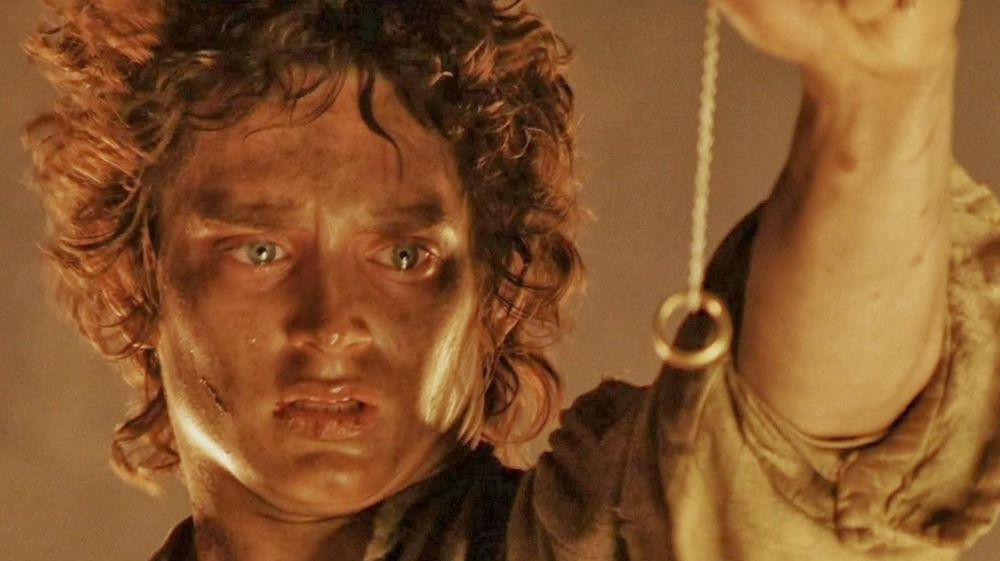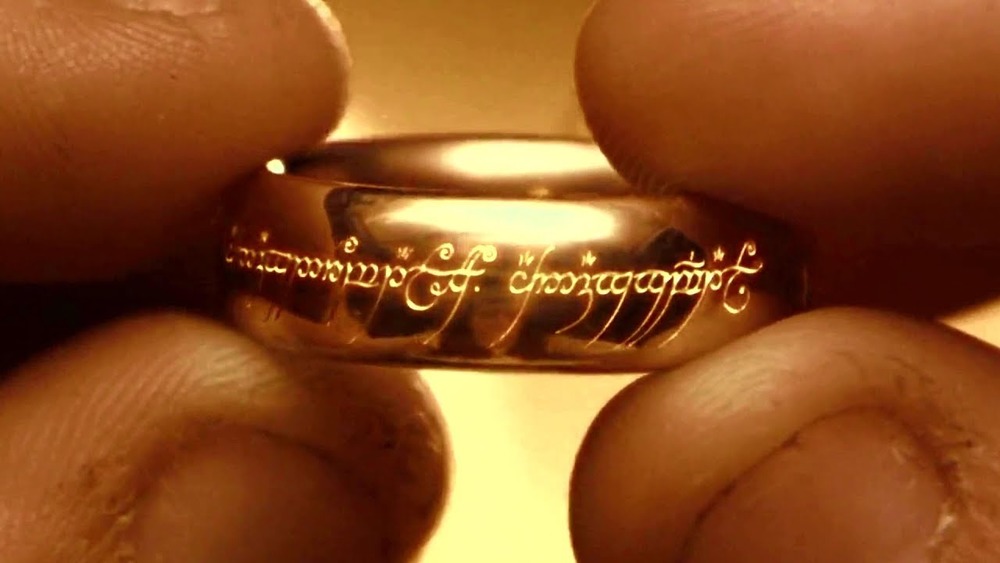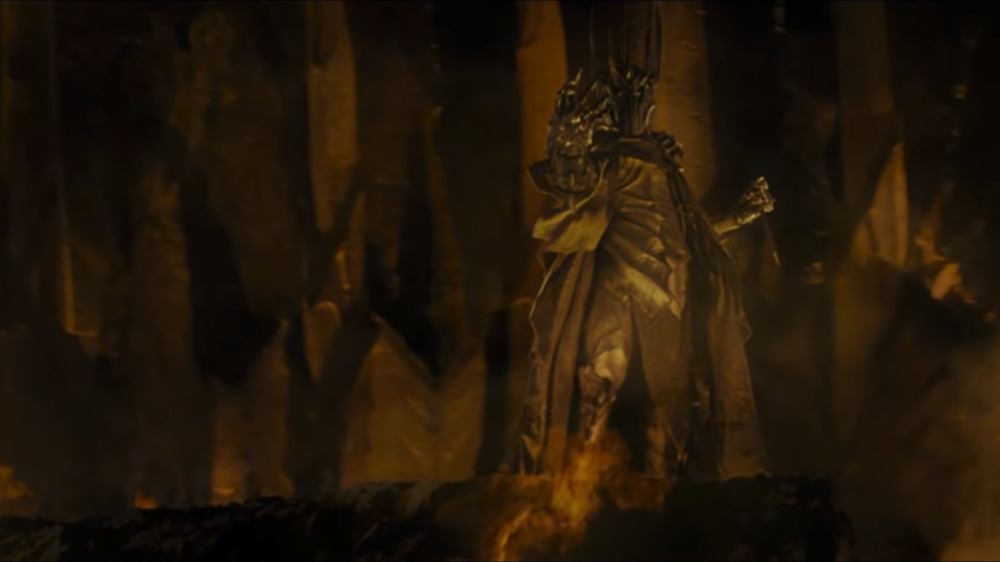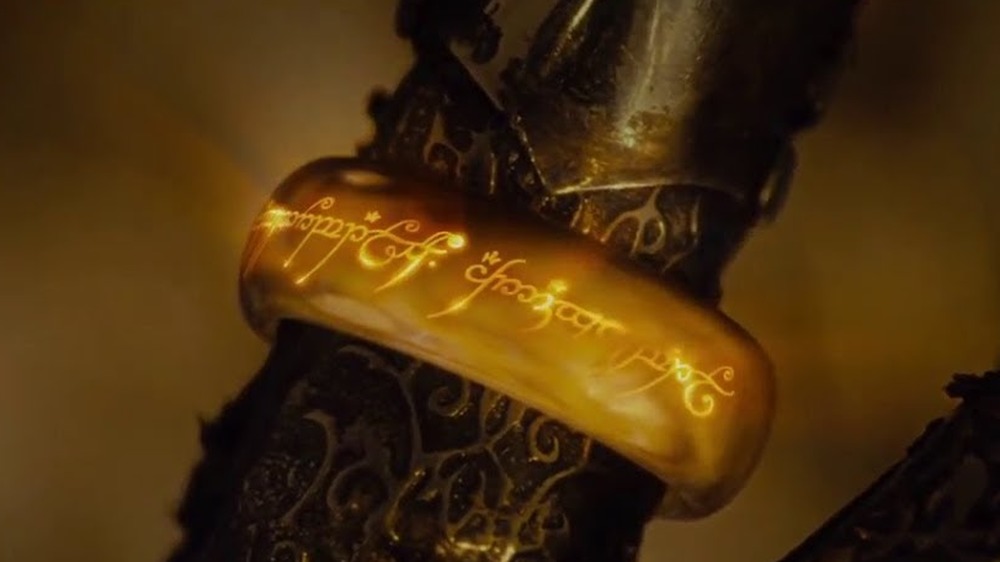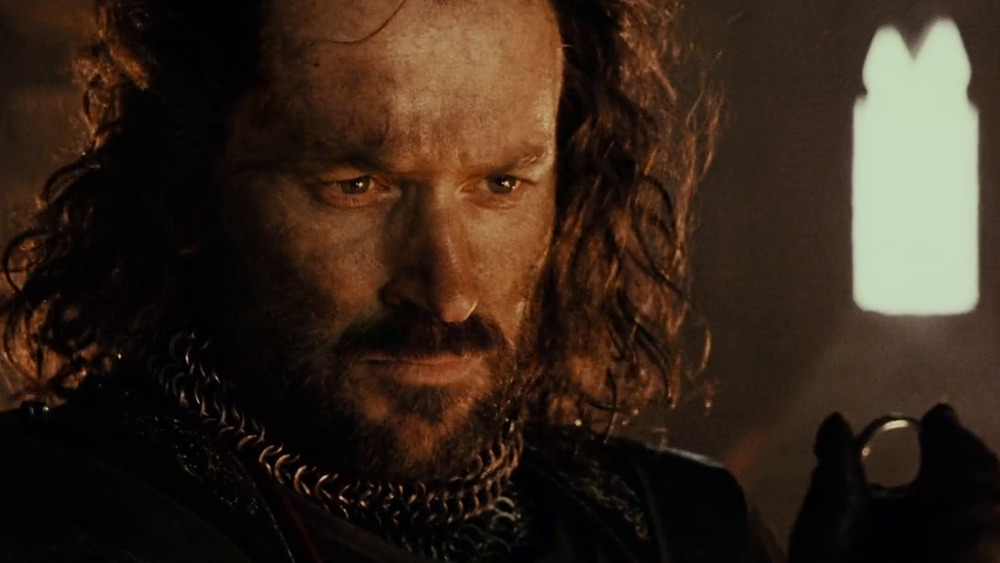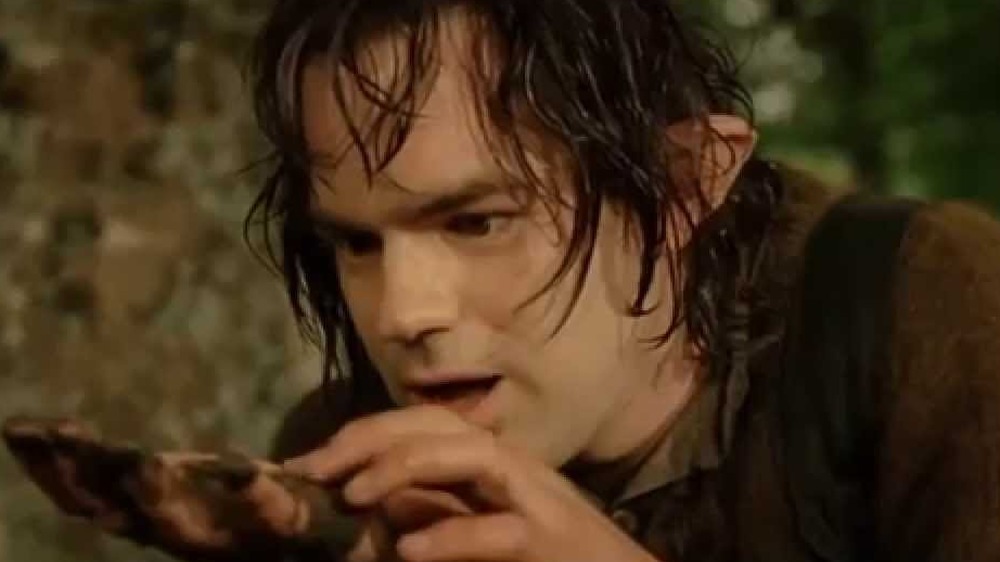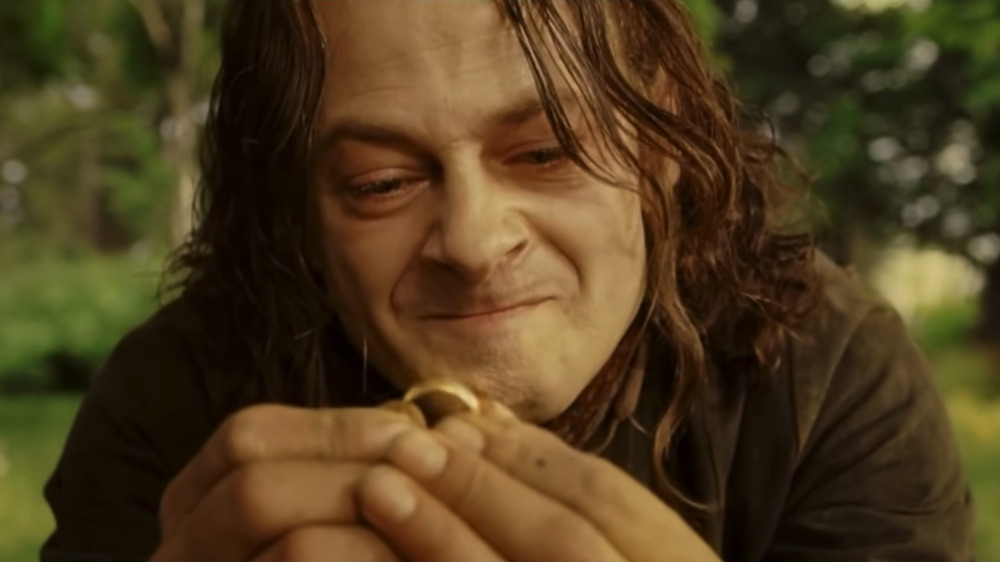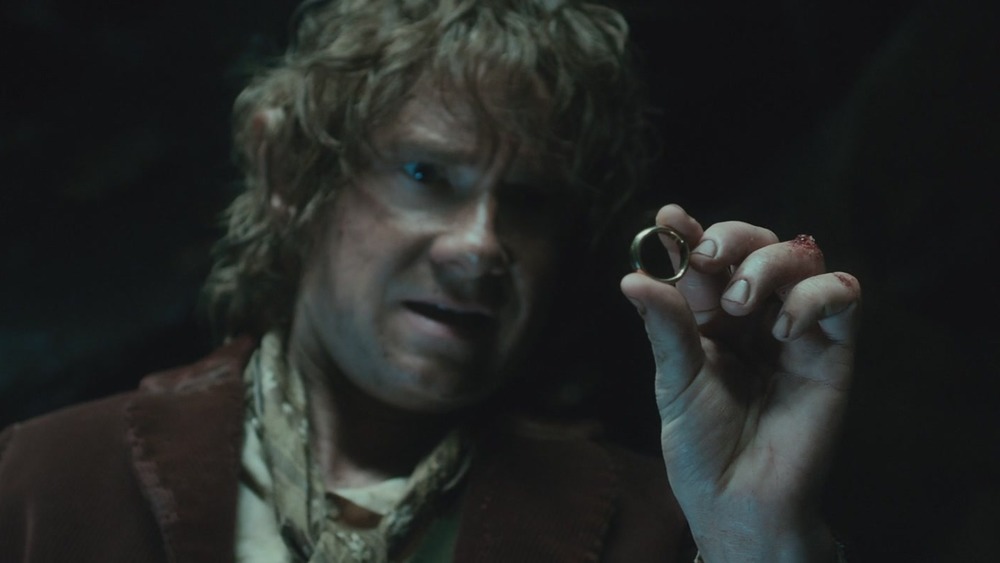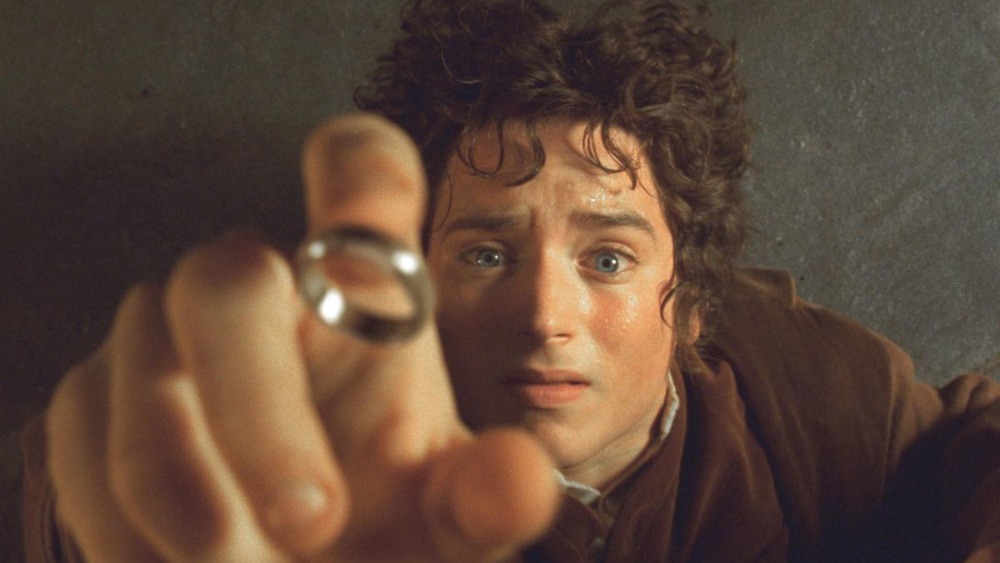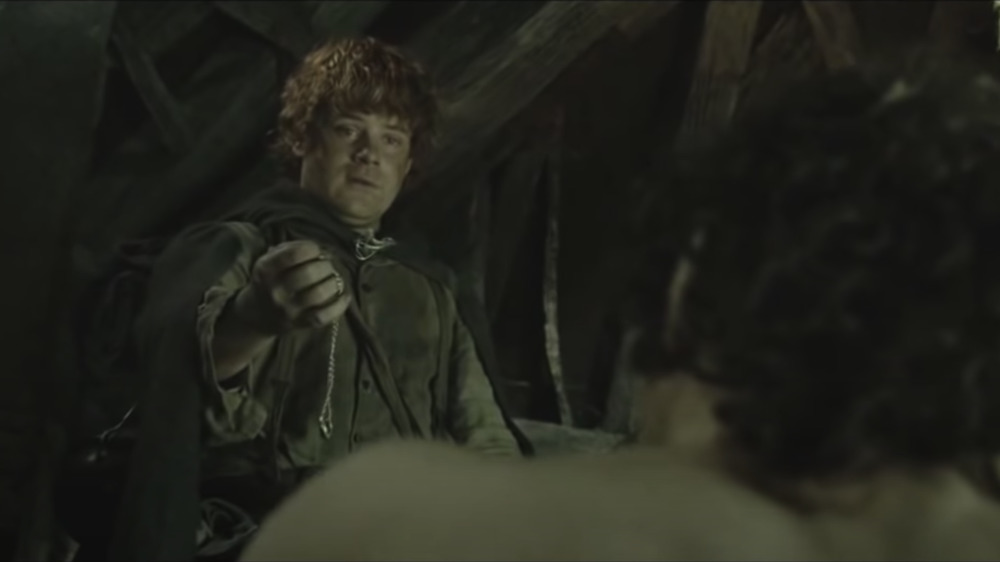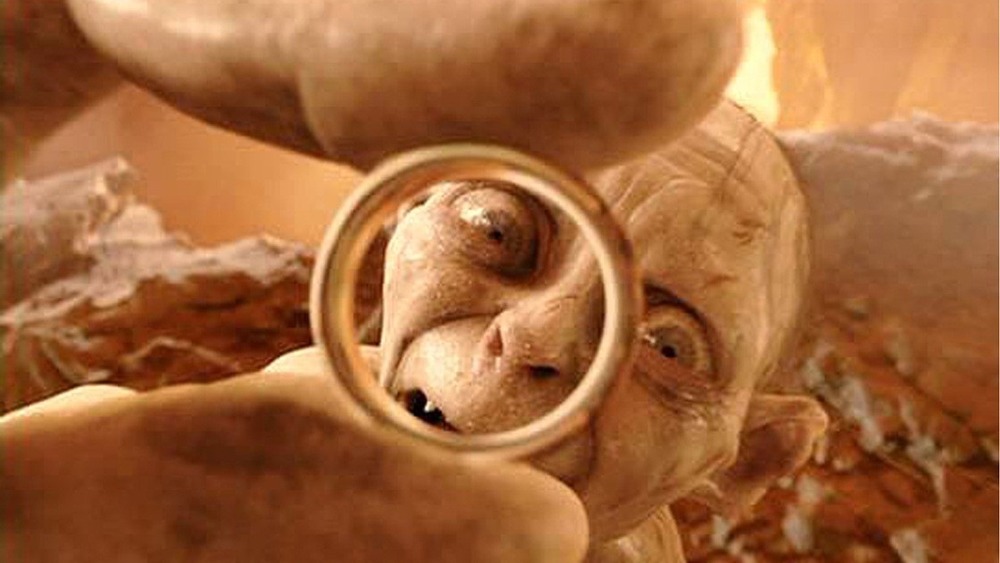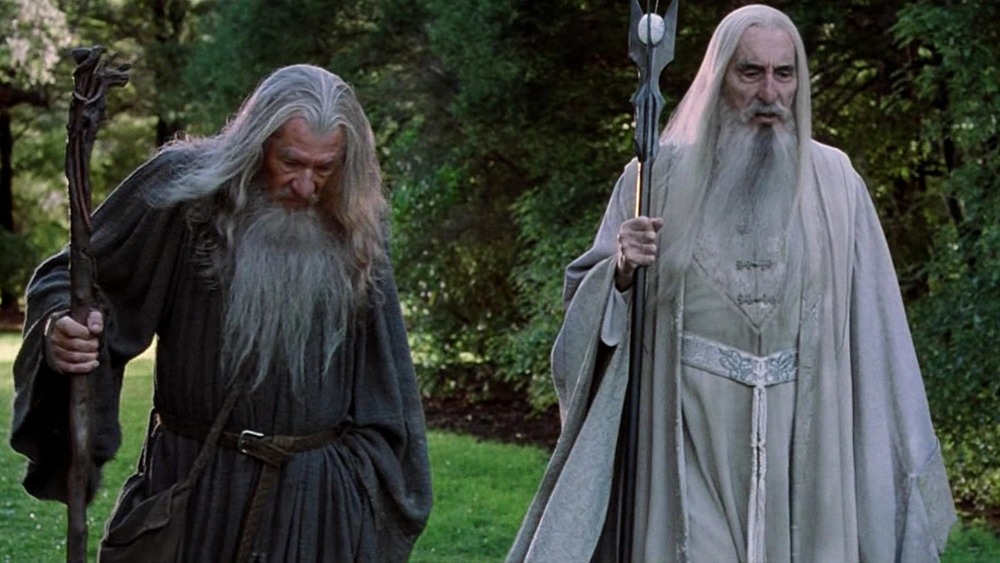Lord Of The Rings: Every Ring-Bearer In Chronological Order
There are few stories out there in which bearing a shiny trinket is more important than in J.R.R. Tolkien's monumental Lord of the Rings trilogy. After all, this particular piece of jewelry is the One Ring to rule them all and in the darkness bind them. The One Ring is the focal point throughout all three books, as well as The Hobbit that precedes them. It even drops into some of the stories contained within many of Tolkien's posthumously published works, like The Silmarillion and Unfinished Tales.
Needless to say, the One Ring is a pretty big deal, as are those who bear it. The question is, who exactly gets a chance to carry the One Ring throughout the bauble's millennia-long existence in Middle-earth? The Lord of the Rings gives us a good perspective of who carries the One Ring right before it meets its end in the fires of Mount Doom. But who has it before then and in what order? To answer these questions, we dove headlong into the vault of original Middle-earth content and have managed to cobble together a complete list of every Ring-bearer. Here it is, with the bearers presented in chronological order.
A quick One Ring primer
Before we start ticking off Ring-bearers, it's helpful to quickly review just what the One Ring is in the first place. See, Tolkien loved to weave various valuable hardware into his lore. The Silmarillion is named after some powerful jewels, the possession of which literally leads to the utterly destructive ending of the First Age. Aragorn's sword is another item that has a huge impact on The Lord of the Rings, as well.
When it comes to magic rings, in particular, Tolkien refers to many of them. However, the best of these are lumped into the category of the Rings of Power — three for the elves, seven for the dwarves, and so on. The One Ring is originally forged by Sauron in the hopes that he could dominate these lesser Rings of Power. While the gambit fails to give him much control over the elves and dwarves, it does provide him with his servants, the Nazgûl. However, it also separates a good portion of Sauron's power from himself, kicking off the long struggle over who currently controls the Ring.
Sauron bears the One Ring first
It should come as no surprise that the first person to bear the One Ring is none other than the Dark Lord himself. After all, it's Sauron who forges the overpowered loop of metal in the first place, right smack dab in the middle of the Second Age of Middle-earth history.
Of course, Sauron was around for a very long time before he made the One Ring. He started out as an angelic being that predated time itself. Eventually, the world was created, and he joined forces with the original Dark Lord, Morgoth. When Morgoth was defeated at the end of the First Age, Sauron stepped into his shoes and became the new Dark Lord.
Throughout the first half of the Second Age, Sauron tries to sucker his enemies, particularly the elves, into trusting him. He puts on an attractive physical appearance and offers to help them make Rings of Power. Then he sneakily makes the One Ring and siphons a bunch of his own power into the shiny trinket in an attempt to control the others. In The Silmarillion, it explains that "much of the strength and will of Sauron passed into that One Ring; for ... that which should govern [the elven-rings] must be a thing of surpassing potency."
Sauron's time with the One Ring
As soon as Sauron finishes making the One Ring, the elves perceive that they've been duped and take off their rings. Again, in The Silmarillion, it explains that the elves "were not so lightly to be caught," adding that "as soon as Sauron set the One Ring upon his finger, they were aware of him. ... Then in anger and fear they took off their rings."
This lack of willing cooperation from his enemies leaves the Dark Lord with no other option than to resort to brute force. This leads to a series of knock-down, drag-out wars that stretch throughout the rest of the Second Age. Towards the end of that time, Sauron is captured (technically, he willingly surrenders) by the powerful men of the island nation of Númenor, leaving the Ring behind as he heads into captivity. Once on his captors' island, though, the villain bewitches their king and ends up causing the entire landmass to sink into the waves in an Atlantis-like catastrophe. The Silmarillion explains that Sauron temporarily loses his physical form in the disaster, but his spirit flees back to Mordor where "he took up again his great Ring ... and dwelt there, dark and silent."
But before he's able to revel in the complete destruction of his overseas enemies, he learns that a small group of survivors have escaped the carnage and arrived off of the shores of Middle-earth. They're led by a fellow named Elendil, along with his sons Anárion ... and Isildur.
Isildur heroically becomes the second Ring-bearer
After the survivors of Númenor arrive in Middle-earth and establish new kingdoms (one of which is Gondor, by the way), it doesn't take long for them to get into yet another tussle with Sauron. They form the Last Alliance with the elves, and the motley crew of legendary heroes proceeds to attack Mordor, slowly wearing Sauron's forces down over the next seven years.
By the end, the now-desperate Dark Lord, who's taken on a horrifying new physical form, finally comes out in all of his hideous glory and attempts to defeat the invaders himself. During the fight, Isildur uses the shards of his fallen father's sword, Narsil, and manages to cut the One Ring off of Sauron's hand. The sudden loss of his potent knickknack immediately deflates the Dark Lord, destroying his physical body and leaving him once again as little more than a wandering spirit.
In the meantime, the victorious Isildur claims the One Ring for his own and rejects the advice of those around him, including Elrond, to destroy it. Instead, Isildur keeps the Ring and then goes back to rule his fledgling kingdoms. At his first stop in Gondor, he fills out the scroll that Gandalf later finds, detailing his new Ring and its engravings. From there, he heads to his realm in the north of Middle-earth, but on his way, the new Ring-bearer is ambushed by orcs.
The Anduin 'bears' the Ring for a really long time
When Isildur is ambushed by orcs, the king's own son, Elendur, tells his father to escape before the One Ring is recaptured, leading to the father's epic last words, "Forgive me, and my pride that has brought you to this doom." As an invisible Isildur tries to escape by swimming across the nearby River Anduin, he's betrayed by the Ring, which slips from his hand into the flowing water. Suddenly visible, the Númenórean king is subsequently shot by archers, and the River Anduin becomes the unexpected new inheritor of the Ring.
While a body of water hardly a Ring-bearer makes, we're going to at least give the Anduin an honorable mention here — if only because of the amount of time that the One Ring spends buried in the murky riverbed. When you add it up, the Ring is going to spend more time in the watery arms of the Great River than it does with any of the actual Ring-bearers. Even Sauron, who has it the longest, possesses the Ring for under 2,000 years, whereas it's about to lie in the muck and mud for nearly 2,500 years. In The Fellowship of the Ring, Gandalf even quotes Saruman as saying, "Into Anduin the Great it fell; and long ago, while Sauron slept, it was rolled down the river to the sea. There let it lie until the end." But, of course, it wasn't the end. Not by a long shot.
Déagol briefly — and tragically — becomes the third Ring-bearer
After spending the bulk of the Third Age at the bottom of the Anduin, the One Ring wakes up one day and realizes that its master is beginning to take on a new form again, initially under the dreadful guise of the Necromancer. Feeling its old master stirring, the Ring manages to begin the process of getting back to him by orchestrating an underwater recovery by the most unlikely creature imaginable — a hobbit. Well, at least a relative of the hobbits.
See, several hundred years before The Lord of the Rings takes place, a pair of friends named Déagol and Sméagol head out on a fishing trip. The pals come from a hobbit-like people that live on the banks of the Anduin at the time. During the trip, Déagol is pulled right into the water when a giant fish nabs his line. He's dragged to the bottom of the river, and there, he spots something shiny and grabs for it. When he comes up, he discovers that he's found a golden ring. What luck!
Except, yeah, it's the One Ring. When Gollum — er, Sméagol — comes up and sees it, he's overcome by the desire for it and demands that his friend give it to him as a birthday present. When Déagol refuses, his "friend" strangles him and takes the bauble for his own, making Déagol the shortest-lived of all of the Ring-bearers by a very large margin.
Sméagol becomes the precious fourth Ring-bearer
After he murders his friend and claims the One Ring, it doesn't take long for Sméagol to get into a bit more trouble. The loose cannon becomes nastier by the day until he's ousted by his own friends and family, who nickname the mischief-maker "Gollum," due to a noise that he starts making in his throat.
The exiled Gollum flees with the Ring, and he eventually sets up shop on a slimy island in the middle of a lake in the deep underbelly of the Misty Mountains. Here, he obsesses over his precious possession for the next five centuries. During this time, his body doesn't get older, thanks to the Ring's power to delay age. Nevertheless, he doesn't seem to actually wear the Ring too often, which is why he never actually turns permanently invisible — like the Black Riders — but rather evolves into a grotesque creature that hates everything around him. Interestingly, he hates the Ring most of all but remains desperately consumed by its entrancing desire as the centuries slowly pass by.
Bilbo accidentally becomes the fifth Ring-bearer
Truth be told, shifting from a riverbed to the bottom of a mountain can hardly be called progress, and eventually, the Ring feels its time to try responding to its master's call yet again. At a random point when Gollum wears the ring to hunt some dinner, it decides to slip off of his finger — the same way it did with Isildur. From there, it hitches a ride with yet another small creature, Bilbo Baggins from the Shire.
This happens when the hobbit accidentally wanders down to Gollum's subterranean home during his adventure to free the Lonely Mountain from the dragon Smaug. He accidentally finds the Ring as he gropes blindly in the dark and pops it into his pocket without a second thought, inadvertently becoming the fifth individual to bear the Ring in the process. Bilbo's story continues on from there, as he navigates numerous adventures, helps to defeat Smaug, and survives the Battle of Five Armies.
Throughout this time, as well as the decades of peaceful retirement that follow his quest, Bilbo becomes ever more attached to the Ring. Eventually, his friend, the wizard Gandalf the Grey, starts to pick up on the fact that Bilbo's nifty piece of magical jewelry may be more than it seems. He becomes so concerned that he convinces Bilbo to give it to his younger cousin, Frodo, on his 111th birthday. This makes Bilbo the first of just two Ring-bearers to willingly surrender the One Ring to another owner.
Frodo's inheritance makes him the sixth Ring-bearer
Frodo Baggins is a young orphan who's brought to live with his older cousin (not his uncle, thank you very much), Bilbo, when he's still a youngster. On his 33rd birthday — the age that hobbits "come of age" — Frodo inherits Bilbo's estate, including the One Ring. Wisely warned by Gandalf to avoid using Bilbo's mysterious Ring, Frodo becomes the one person to both possess and not use the One Ring for nearly two decades.
It isn't until he's nearly 50 years old that Frodo officially learns what the Ring is, and he realizes that he must do something to stop the Dark Lord from recapturing it. This, of course, sparks the events of The Lord of the Rings, in which Frodo and his hobbit friends flee from the Shire, are helped by Aragorn, and eventually find their way to Rivendell. Once there, they join the Fellowship of the Ring, and Frodo retains his role as the official Ring-bearer.
The group then heads out on the quest to reach Mount Doom in Mordor. This is where the Ring was forged, and it's the one place in Middle-earth where it can be destroyed. Throughout the quest that follows, Frodo remains the primary Ring-bearer, but that doesn't mean he retains possession of the Ring the entire time.
Samwise briefly becomes the seventh Ring-bearer by necessity
Here, almost 5,000 years after the One Ring is forged, we finally meet Samwise the Stouthearted, the seventh and last of the Ring-bearers. Samwise's stint with the One Ring is fairly brief in Peter Jackson's Return of the King film. However, in the original source material, after he defeats Shelob and thinks his master has died, Sam actually puts on the Ring for quite a while. In The Two Towers, when Sam slips the precious bauble onto his finger, it explains that "a single moment of time was filled with an hour of thought." He's also given sharpened hearing but dimmed sight, and the world around him becomes "vague." It also implies that the Ring gives him "understanding of tongues, or simply understanding."
Eventually, Sam heads into Mordor to track down his master, and when he does so, he wisely avoids wearing the Ring any further. When he finds Frodo, he dutifully returns the Ring, although in The Return of the King, it clarifies that he "felt reluctant to give up the Ring and burden his master with it again." Still, he manages to give it to Frodo without too much drama, making him just the second person to willfully hand the Ring over to someone else. Sam's time with the Ring is brief but important — so important that in the appendix to The Return of the King, it actually says that in his old age, "Samwise ... went to the Grey Havens, and passed over Sea, last of the Ring-bearers."
Frodo and Gollum get to bear the Ring one more time each
At this point, we've covered the seven Ring-bearers in order. However, it's worth pointing out that two of them get one more chance to bear the precious burden. The first is obviously Frodo. The sixth Ring-bearer gets the Ring back from Sam on the edge of Mordor and then carries it for the final trip to Mount Doom.
They're dogged by Gollum on every step of the journey, and once they reach Mount Doom, the fourth Ring-bearer makes his final move. He attacks Frodo at the Crack of Doom, and as they tussle over the fiery abyss, Gollum manages to bite Frodo's finger off and reclaim the Ring once more. In the books, this is followed by Gollum's trip-and-fall accident, in which he slips and tumbles backward off of the brink. In the film, Frodo tackles Gollum off the cliff, though he manages to climb back up to safety. Peter Jackson later revealed that they even nearly had Frodo push Gollum off of the cliff on purpose in a vengeful act of murder. Regardless of the specifics, though, in all of the above cases, the One Ring goes over the edge with the fourth Ring-bearer and meets its fiery end.
Honorable Mentions
While there are seven official "Ring-bearers," it's worth giving an honorable mention to a few other characters, along with the previous nod to the River Anduin.
First, there's Gandalf because, if you're going to be technical about it, he actually does "bear the Ring" for a few seconds at two different points. In The Fellowship of the Ring, after Bilbo's party, the birthday boy drops an envelope for Frodo — which contains the Ring — on the floor, at which point "the wizard stooped and seized it and set it in its place." Roughly 17 years later, the wizard holds the Ring one more time when he takes it from Frodo and throws it into the fire to reveal the writing on its band.
Another honorific goes to the villain Saruman. Unlike Gandalf, Saruman never actually gets his traitorous hands on Sauron's trinket. Nevertheless, he studies Ring lore for centuries, tries to make his own rings, and at one point, even uses the Dark Lord as bait to figure out where the One Ring might be hiding. And don't forget, it's his Uruk-hai that carry off Merry and Pippin as part of his attempt to recover the Ring for himself. While he doesn't actually bear the Ring, he's second in line after Sauron when it comes to the desire to do so.
And then there's Tom Bombadil. The jolly old enigma is only known to fans of the books, as he was cut out of Peter Jackson's films. Bombadil is a mysteriously powerful being that lives near the Shire. When Frodo and company stumble upon his house as they begin their trip to Rivendell, he gives them shelter for a couple of days. In The Fellowship of the Ring, it's explained that during this time Tom asks to see the Ring. When Frodo gives it to him, "Tom put the Ring round the end of his little finger and held it up to the candlelight...Then they gasped. There was no sign of Tom disappearing!" While the Ring doesn't have any power over this merry fellow, it doesn't change the fact that he both bears and wears the Ring... for a few seconds, at least.
Oh yeah, Boromir holds the ring for a second, too — you know, when it inexplicably falls off of Frodo's neck into the snow — but that's just in the movies, so it doesn't really count.
